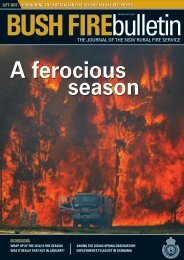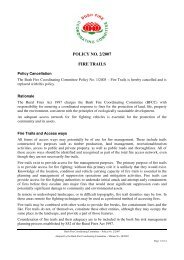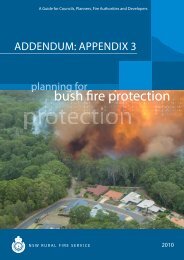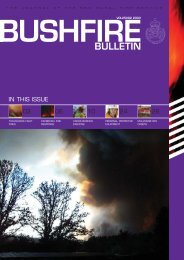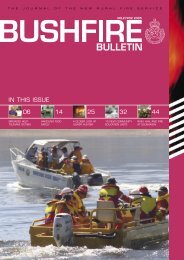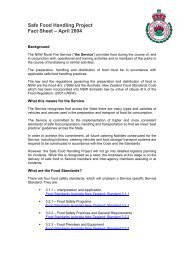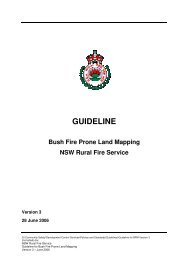Volunteer Professionals - NSW Rural Fire Service - NSW Government
Volunteer Professionals - NSW Rural Fire Service - NSW Government
Volunteer Professionals - NSW Rural Fire Service - NSW Government
Create successful ePaper yourself
Turn your PDF publications into a flip-book with our unique Google optimized e-Paper software.
04 OBJECTIVE It became apparent during the year, and particularly at the time of the Christmas 2001<br />
bushfires, that the levels of competency – at managerial and operational levels of the<br />
<strong>Service</strong> – had improved substantially since the 1994 bushfire emergency.<br />
It is beyond question that the investment of money and time reaped dividends over<br />
and above what could reasonably have been expected of a volunteer organisation.<br />
The <strong>Service</strong>’s relatively small cadre of full-time training staff worked exceptionally<br />
hard to meet high demands for training at local levels and their efforts are to be<br />
commended. Complementing the commitment of the training staff was an equal<br />
commitment from volunteers wishing to improve their competency levels over the<br />
full range of training programs. Currently, out of a <strong>Service</strong> membership of 65,395,<br />
the levels of firefighter qualifications and classifications are as follows:<br />
• 33,962 active firefighters are competent to Bush <strong>Fire</strong>fighter (BF) level or higher;<br />
• 5,142 brigade officers are certified competent to Crew Leader (CL) level or higher;<br />
• 760 members certified competent to Group Leader (GL) level or higher;<br />
• 1,793 members successfully completed <strong>Service</strong> first aid training.<br />
To support the <strong>Service</strong>’s training activities there are 1,579 local instructors and<br />
432 assessors.<br />
The <strong>Service</strong> renewed its status as a registered training organisation with the <strong>NSW</strong><br />
Vocational Education and Training Accreditation Board (VETAB).<br />
Overall, the Training Committee developed training direction through significant input<br />
by salaried staff and volunteers, the prime emphasis being placed upon the<br />
development of rural fire districts as local learning units. A key component of this<br />
type of development is the high levels of local input and control of each local<br />
learning unit. Individual districts were networked to other parts of the <strong>Service</strong> to<br />
form an adaptable, integrated learning organisation.<br />
The introduction of a Public Safety Training package next year will provide a main<br />
qualification route for operational staff and volunteers.<br />
20<br />
<strong>NSW</strong> <strong>Rural</strong> <strong>Fire</strong> <strong>Service</strong> Annual Report 2001/02



